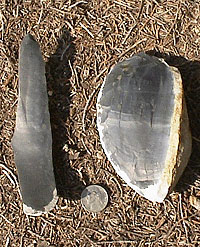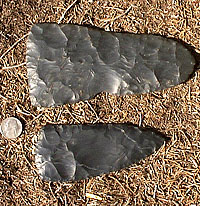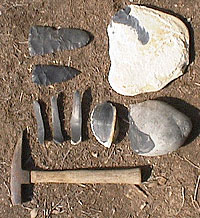Brushy Creek Black
Brushy Creek Black flint is one of the names used to described a fine black flint that occurs mainly along Brushy Creek in the vicinity of Round Rock, Texas. This material is even more localized than Georgetown flint, and less abundant, so it was never spread far and wide among ancient knappers, although it was much coveted. Brushy Creek black is an exceptional flint that in some ways possibly exceeds Georgetown in 'flake-ability.' It is glassy, slightly translucent, and brittle, but it seems less prone to breakage than Georgetown.
It occurs in forms similar to Georgetown and is found in similar geological contexts in the Edwards Limestone Formation, varying only in color. Flat nodule and rounded cobbles are the most common forms, although thin bands also occur; thin bands and flat cobbles are sometimes one and the same, depending on the exposure. It is exposed in breaks in the terrain along hills and streams, and occasionally spread across flat plains resembling a lag deposit.
Many prehistoric artifacts made of Brushy Creek Black flint black at were found at the Wilson-Leonard archeological site near Leander, Texas covering a long time span. Elsewhere it seems to have been favored as a material for making corner-tang knives, a fine example of which was found at the Allen Creek site in Austin County.
![]()


